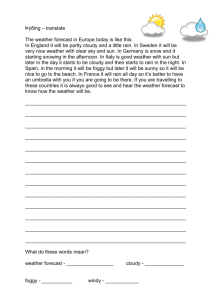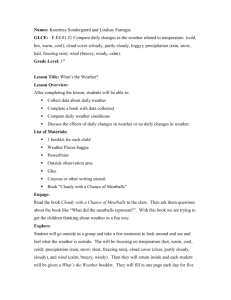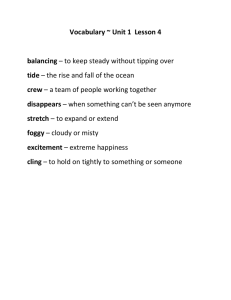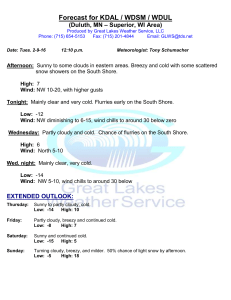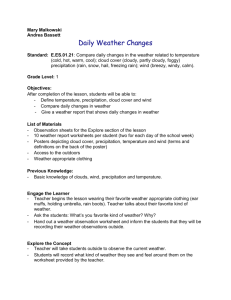Daily Changes in Weather
advertisement
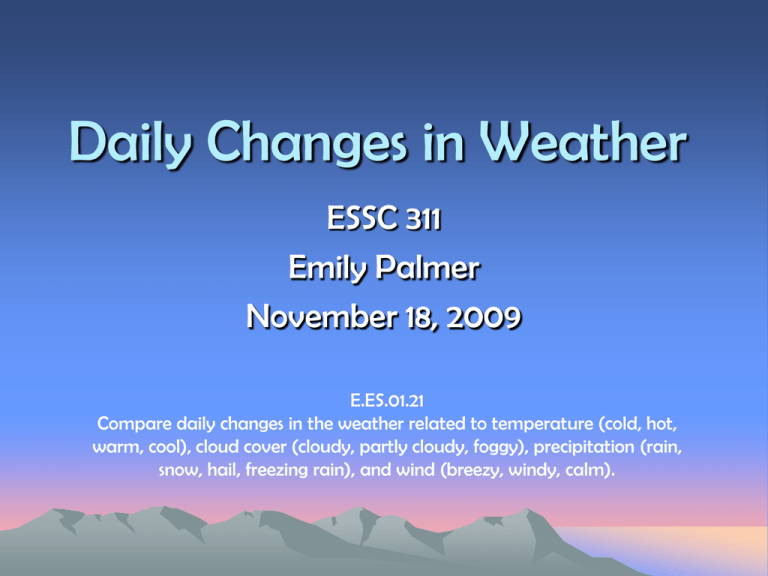
Daily Changes in Weather ESSC 311 Emily Palmer November 18, 2009 E.ES.01.21 Compare daily changes in the weather related to temperature (cold, hot, warm, cool), cloud cover (cloudy, partly cloudy, foggy), precipitation (rain, snow, hail, freezing rain), and wind (breezy, windy, calm). E.ES.01.21 Compare daily changes in the weather related to temperature (cold, hot, warm, cool), cloud cover (cloudy, partly cloudy, foggy), precipitation (rain, snow, hail, freezing rain), and wind (breezy, windy, calm). ENGAGE • • This lesson will be implemented at the beginning of the year, since charting the daily weather changes will be part of our everyday routine. As we finish up morning activities, we’ll sing our weather song to let the students know that it is time to move over to the rug for Weather Time: (to the tune of “Oh My Darling“) • What’s the weather? What’s the weather? What’s the weather, everyone? Is it windy? Is it cloudy? Is there rain? Or is there sun? During the first week, we’ll read The Magic School Bus Kicks Up A Storm and after that, I’ll keep it in the classroom library for the children to look at. E.ES.01.21 Compare daily changes in the weather related to temperature (cold, hot, warm, cool), cloud cover (cloudy, partly cloudy, foggy), precipitation (rain, snow, hail, freezing rain), and wind (breezy, windy, calm). EXPLORE • In order to start looking at the daily changes in weather, we will go outside to watch what the weather is like right now. • When we’re outside, we’ll make observations about what the weather feels like, what the students see in the sky and if anything is falling from the sky. • These observations directly relate to the GLCE, without using the specific vocabulary in it, since the terms won’t be defined until the EXPLAIN section. E.ES.01.21 Compare daily changes in the weather related to temperature (cold, hot, warm, cool), cloud cover (cloudy, partly cloudy, foggy), precipitation (rain, snow, hail, freezing rain), and wind (breezy, windy, calm). EXPLAIN • On our way back into the classroom, we will sing the weather song again, to make sure the students know we are still working with the weather, even though we’ve changed environments. • We’ll sit back on the rug and I’ll explain each of the following terms to the students: sunny, cloudy, partly, cloudy, rainy, snowy, windy, calm, hot, warm, cool, cold. • I’ll make sure to hold up the picture that correlates to the vocabulary so the students become familiar with the images we’ll be using to describe the weather each day. E.ES.01.21 Compare daily changes in the weather related to temperature (cold, hot, warm, cool), cloud cover (cloudy, partly cloudy, foggy), precipitation (rain, snow, hail, freezing rain), and wind (breezy, windy, calm). ELABORATE • The students will tell me what they observed outside and which pictures I should put up for today. • The weather chart can be formatted in many different ways: – A linear chart where the whole month of weather is stretched in one line around an area of the room. This will help children see day-today trends and how long those trends last. – A bar chart where there are categories of weather: if it is sunny, we’ll put a sun in the sunny category. At the beginning of each month, children can predict which category will be filled the most. – A calendar chart where the pictures that apply to each day are put up. This allows the students to classify the daily weather in more than one way. E.ES.01.21 Compare daily changes in the weather related to temperature (cold, hot, warm, cool), cloud cover (cloudy, partly cloudy, foggy), precipitation (rain, snow, hail, freezing rain), and wind (breezy, windy, calm). ELABORATE cont. • As we move through the year, we’ll discuss seasonal changes (as they relate to months) in order to make predictions about the amount of sunny/rainy/snowy/etc. days we’ll have the next month. • The students can each keep a weather journal, documenting the weather they saw each day, what they think the weather will be like tomorrow and what they think the weather will be like the next month. • The following GLCEs can also be fulfilled through this lesson: – E.ES.01.22 - Describe and compare weather related to the four seasons in terms of temperature, cloud cover, precipitation, and wind. – E.ES.01.32 - Observe and collect data of weather conditions over a period of time. E.ES.01.21 Compare daily changes in the weather related to temperature (cold, hot, warm, cool), cloud cover (cloudy, partly cloudy, foggy), precipitation (rain, snow, hail, freezing rain), and wind (breezy, windy, calm). EVALUATE • • • • Student weather journal Contributions to daily weather report Class discussion and predictions Since this will be a daily activity, it will be easy to constantly evaluate the students as to whether they understand the idea of recording daily changes in weather.
